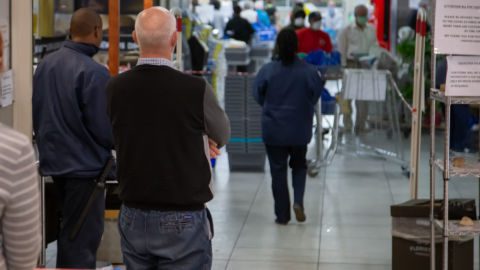 Scientists, philosophers and columnists claim the world as we know it won’t be the same, at least not in the foreseeable future. Since the coronavirus pandemic penetrated our life during the last few months, the way we live, buy, consume, work and even socialize with our families and friends may have changed forever. Governments around the globe are following the WHO recommendations: Quarantining potentially infected people and keeping people away from office buildings, shopping centers, stores and beaches to help stop the spread of the virus and “flatten the coronavirus curve”.
Scientists, philosophers and columnists claim the world as we know it won’t be the same, at least not in the foreseeable future. Since the coronavirus pandemic penetrated our life during the last few months, the way we live, buy, consume, work and even socialize with our families and friends may have changed forever. Governments around the globe are following the WHO recommendations: Quarantining potentially infected people and keeping people away from office buildings, shopping centers, stores and beaches to help stop the spread of the virus and “flatten the coronavirus curve”.
But everybody needs urgent supplies of food, pharmaceuticals and more. The sight of hundreds queueing outside stores wearing masks and gloves and shocking pictures of empty shelves were beyond comprehension. Suddenly, globally, retailers and CPG manufacturers have to work in emergency mode to provide essential services to customers. But how can retailers optimize their operations and adapt to best handle the challenge?
Retailers can provide much better service to the public if they deploy 24/7 available stores with safe environments, minimum staff, readily available products and the ability to keep command of today’s situation — social distancing.
That’s where Autonomous Micro Markets come into play. Some technology solution providers have run this concept with leading global retailers but they were perceived as innovation games and luxury projects. Now it turns out that they are the right solution at the right time.
What is an Autonomous Micro Market? In general, the idea is a solution, similar to a modern convenience store, that best meets the typical needs of current urban lifestyle shoppers. These are typically young people, looking for pleasant, fast, frictionless digital shopping experiences, minimum interaction with the staff, 24/7 availability and readily available products.
Micro markets have existed for quite some years. But most of them are open and trust-based, where at the end of the journey in the store the shopper scans the products in a standard self-checkout station.
The new trend is the closed Autonomous Micro Market, providing the solution to the above-mentioned needs.
Typically, these micro markets are 30 to 50 square meters with well-organized open bays (shelves) and fridges. Normally, a store like that will include 200 to 500 different products (SKUs), with precise stock based on data analysis of sales and consumer behavior. Operating a micro market in today’s disrupted retail market will require integration of best of breed solutions to increase the value proposition.
The customer journey will be as follows: Swiping or tapping the credit card or any other payment device, the shopper is authorized by the Micro Market Management System to enter the store via an electronic door. The shopper is tracked by video cameras (which can cause a challenge with privacy issues), or preferably sensors based on less intrusive technology such as LiDAR, which performs the same without compromising privacy.
The shopper pattern is analyzed in conjunction with the pickup list of products that will be based on product identification technology. Smart shelves based on digital weighing sensors become more and more popular as the preferred solution for product identification — accurate, cheap, easy to maintain. Yet other technologies such as video analytics and RFID could be used. Additional add-on solutions such as electronic labeling, in-store digital signage and more could be integrated. At the end of the shopper journey, the store management system summarizes the shopping cart per shopper, then presents the “basket” and the requested payment. As the shopper walks out, payment is completed.
As the coronavirus challenges retailers, more creative technology-driven solutions could turn the Autonomous Micro Market into a safer environment for essential shopping. For example, the management system could be temporarily configured to allow only one shopper at a time to enter the store. If some shoppers are allowed inside, LiDAR sensors can alarm shoppers if they get too close per social distancing instructions. Some environmental sensors can set off alarms if the air inside the store is not clean enough, and under some conditions activate sanitizers, air ventilation and other measures.
Scientists claim the world should expect a second global wave of COVID-19 in the October-December timeframe. This gives us time to prepare. It is a wakeup call for retailers worldwide to accelerate projects of Autonomous Micro Markets at urban areas as their contribution to fight this pandemic.
Watch a demo of Autonomous Micro Market at the last Euroshop expo: https://youtu.be/t4puT_Ofqnk
Udi Wiesner is the General Manager of The Retail Innovation Division of Shekel Brainweigh Ltd., a worldwide leading provider of digital weighing systems. He has served as the General Manager of VeriFone Israel, GM Software Division of Afcon Control & Automation Ltd. and Sales Division Manager of Sun Microsystems Israel, among others. The Retail Innovation Division provides solutions for Autonomous Micro Market like the “Capsule” full framework, and Innovendi – next generation of vending Micro Markets. The company provides its solutions to leading retailers and vending machines operators in Europe, the U.S. and Australia. The company has aligned in a global agreement with Hitachi to provide their full solutions for Autonomous Micro markets.













